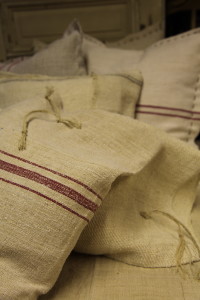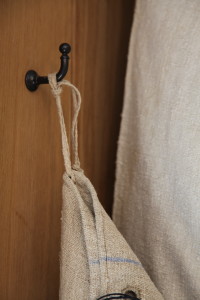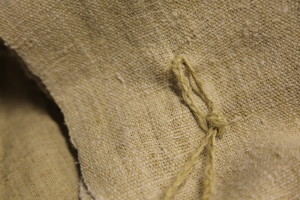A technique whereby three ribbons, cords or fabric lengths are woven together in a certain order to create a typical twist that is extremely attractive and easy to make, and very sturdy. A plaited length is far stronger than any single or even twisted length, being the sum of its parts. For this reason, load bearing yarns and ropes are often plaited.
Many of us have at some stage in our lives had plaits or pigtails, we learn to do them when we are children. Dreadlocks and many of the most stunningly beautiful hair designs have grown around the technique of plaiting. Plaiting is sculptural, it uses the same material to create a new dimension. And the craftsmanship, the act of manipulation is notable. It’s a very beautiful thing.
Our flour sack cushions often arrive with plaited hemp ties, or strings, with which the tops were tied and we now use to hang them up. If they don’t come with plaited ties we often make them, using lengths of hemp frayed from any offcuts.
Some years ago we were trying to make some informal tie backs for a clients curtains – I’ve always disliked the unfriendly, poorly designed, hard half -moon tie back shapes that have come from goodness know where, and any of the trimmings we looked at – cords, tassels, loops, just didn’t seem quite right. So we looped fabric around into sashes etc. and came up with the idea of plaits. A few months later they were on on the front cover of House and Garden – not mine though, so there must have been something ‘in the air’ that drove the idea. We make soft rolls filled with medium weight cotton interlining or wool batting ( sometimes polyester wadding ) and plait them together to make squashy, soft, informal tie backs, that being of the same fabric as the curtains blend in, but also add a welcome extra dimension. They also hold the curtains in a good shape, the softness prevents the leading edges from creasing as much as they can with other types of tie back.



